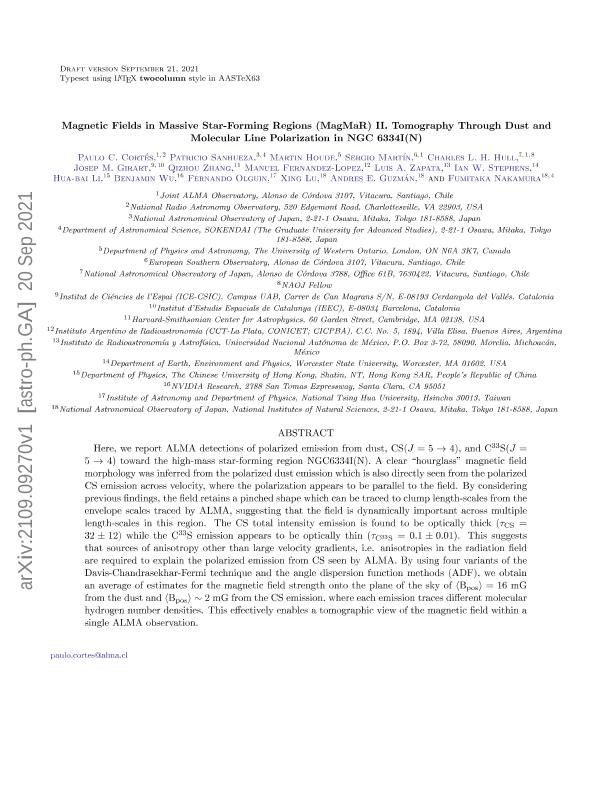Artículo
Magnetic Fields in Massive Star-forming Regions (MagMaR). II. Tomography through Dust and Molecular Line Polarization in NGC 6334I(N)
Cortés, Paulo C.; Sanhueza, Patricio; Houde, Martin; Martín, Sergio; Hull, Charles L. H.; Girart, Josep M.; Zhang, Qizhou; Fernandez Lopez, Manuel ; Zapata, Luis A.; Stephens, Ian W.; Li, Hua Bai; Wu, Benjamin; Olguin, Fernando; Lu, Xing; Guzmán, Andres E.; Nakamura, Fumitaka
; Zapata, Luis A.; Stephens, Ian W.; Li, Hua Bai; Wu, Benjamin; Olguin, Fernando; Lu, Xing; Guzmán, Andres E.; Nakamura, Fumitaka
 ; Zapata, Luis A.; Stephens, Ian W.; Li, Hua Bai; Wu, Benjamin; Olguin, Fernando; Lu, Xing; Guzmán, Andres E.; Nakamura, Fumitaka
; Zapata, Luis A.; Stephens, Ian W.; Li, Hua Bai; Wu, Benjamin; Olguin, Fernando; Lu, Xing; Guzmán, Andres E.; Nakamura, Fumitaka
Fecha de publicación:
12/2021
Editorial:
IOP Publishing
Revista:
Astrophysical Journal
ISSN:
0004-637X
Idioma:
Inglés
Tipo de recurso:
Artículo publicado
Clasificación temática:
Resumen
Here, we report ALMA detections of polarized emission from dust, CS(J = 5 → 4), and C33S(J = 5 → 4) toward the high-mass star-forming region NGC 6334I(N). A clear “hourglass” magnetic field morphology was inferred from the polarized dust emission, which is also directly seen from the polarized CS emission across velocity, where the polarization appears to be parallel to the field. By considering previous findings, the field retains a pinched shape that can be traced to clump length scales from the envelope scales traced by ALMA, suggesting that the field is dynamically important across multiple length scales in this region. The CS total intensity emission is found to be optically thick (τ CS = 32 ± 12) while the C33S emission appears to be optically thin (). This suggests that sources of anisotropy other than large velocity gradients, i.e., anisotropies in the radiation field, are required to explain the polarized emission from CS seen by ALMA. By using four variants of the Davis–Chandrasekhar–Fermi technique and the angle dispersion function methods (ADF), we obtain an average of the estimates for the magnetic field strength on the plane of the sky of mG from the dust and mG from the CS emission, where each emission traces different molecular hydrogen number densities. This effectively enables a tomographic view of the magnetic field within a single ALMA observation.
Palabras clave:
POLARIMETRY
,
STAR FORMATION
Archivos asociados
Licencia
Identificadores
Colecciones
Articulos(IAR)
Articulos de INST.ARG.DE RADIOASTRONOMIA (I)
Articulos de INST.ARG.DE RADIOASTRONOMIA (I)
Citación
Cortés, Paulo C.; Sanhueza, Patricio; Houde, Martin; Martín, Sergio; Hull, Charles L. H.; et al.; Magnetic Fields in Massive Star-forming Regions (MagMaR). II. Tomography through Dust and Molecular Line Polarization in NGC 6334I(N); IOP Publishing; Astrophysical Journal; 923; 2; 12-2021; 1-24
Compartir
Altmétricas



